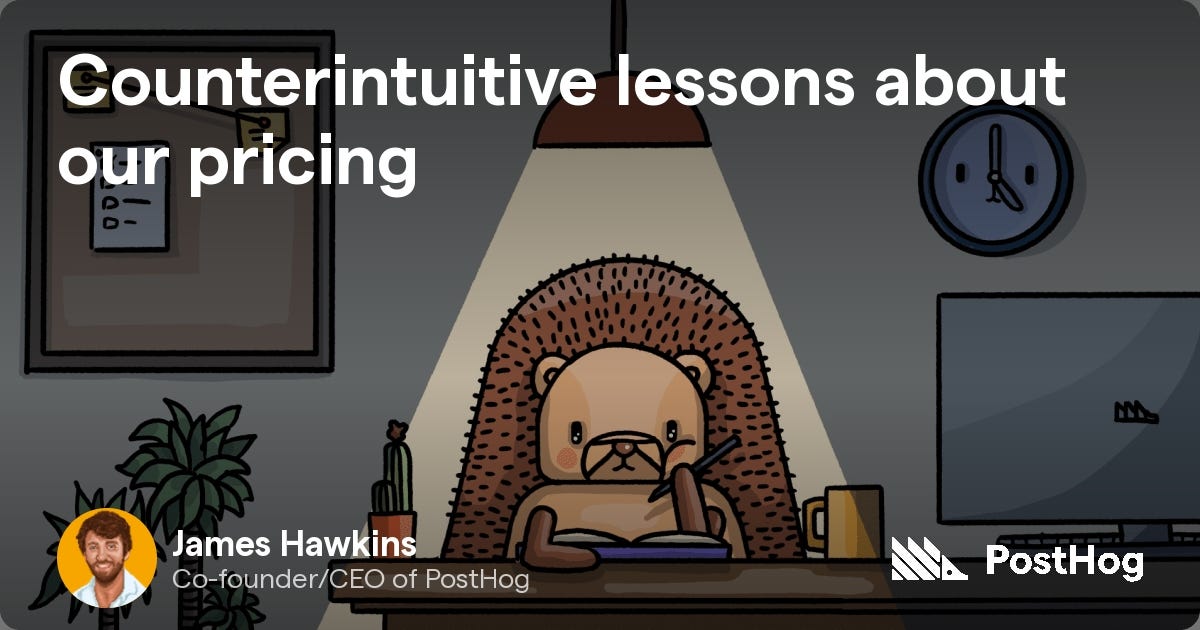DevTools Brew #28: How to Scale Engineering Teams with GitHub's Former CTO, 5 Unintuitive Lessons About Pricing from PostHog CEO, The State of Series A Funding...
Dear friends, welcome to DevTools Brew #28!
Hello to the 113 new folks who have joined Devtools Brew since the last edition.
If you're new here, my name is Morgan Perry, co-founder of Qovery, and every Saturday, I share the stories, strategies, and insights behind the successful devtool companies.
In this Issue #28:
📈 How to Scale Engineering Teams with GitHub's Former CTO
💻 5 Unintuitive Lessons About Pricing from PostHog CEO
💸 The State of Series A Funding: Insights for Devtool Startups & Investors
⭐ Star History Weekly Pick
💰 Latest Devtools Funding Rounds
I hope you will enjoy this new edition.
Let's dive in!
📈 How to Scale Engineering Teams with GitHub's Former CTO
I'm excited to share this piece of content with Jason Warner, the former CTO of GitHub. Jason has navigated the intricate landscape of engineering teams at scale, and he's here to share over a dozen transformative insights and must-dos for architects of hypergrowth. Let’s delve into the key takeaways 👇
Before we explore Jason's expert advice, let's get acquainted with the mind behind it. Jason Warner has a stellar tech pedigree:
Founder of Poolside: Building a foundational AI model similar to ChatGPT but with a different objective
GitHub CTO: Steering the ship at GitHub, the globe's premier open-source hub.
VP of Engineering at Heroku: Overseeing one of the world's largest cloud computing providers.
Product Engineering Maestro: Leading product engineering for Ubuntu Desktop and Ubuntu Phone at Canonical, making Linux accessible to all.
Now, let's dive into the key takeaways from Jason's advice on architecting and scaling engineering teams:
12 Learnings on Scaling Engineering Teams
1. Deciphering Culture's True Essence
Culture isn't just ping-pong tables and snacks; it's about accountability and behavior.
As a leader, your actions set the standard for your organization.
2. Liberation from Tech Shackles
Technology should empower, not ensnare.
Don't let your own tech creations become obstacles to growth.
3. Mission and Vision as Cornerstones
Define a clear mission and vision for your company and share it extensively.
Every member should know why they're part of the journey and who they're building for.
4. Embrace Principles and Practices
Establish non-negotiable principles and practices that define your company's values.
These serve as anchors for your team to navigate their daily tasks.
5. Context Matters
Adapt best practices to your organization's size, age, and operational style.
What works for others might not be your best fit.
6. Managing Expectations
Expectations should reflect the intersection of culture and implementation.
Balancing delivery with well-being is key to long-term employee retention.
7. Measure Everything
Success hinges on measurement; you can't improve what you don't measure.
Leverage technology and data for informed decision-making.
8. The Power of Authenticity
Building trust as a leader requires authenticity and vulnerability.
Imperfections make you relatable, while the pursuit of perfection can lead to downfall.
9. Balancing People and Organization
Understand your goals and strike a balance between focusing on the people and delivery.
Be explicit about your leadership mode, whether sociologist or psychologist.
10. Purposeful Hiring Choices
New additions should bring distinct value, not dilute responsibilities.
Seek highly motivated individuals who proactively seek improvement.
11. Flexibility in Organizational Structure
No structure is perfect; adapt to your immediate needs and objectives.
Accept imperfections; they are part of any structure.
12. Trust Your Intuition
Leadership and product success involve intuition as much as data.
Experience hones your instincts; trust your gut.
Quick Dos and Don'ts for Building Engineering Teams
Do ✅
Streamline programming languages and frameworks.
Monitor and maintain your company's market reputation.
Transform complaints into solutions.
Commit to daily self-improvement.
Prioritize a human-centered approach in interactions.
Don't ❌
Overburden with excessive tooling; corrections can follow.
Succumb to the allure of hype cycles; stay true to your mission.
Tolerate a "not my job" mentality; act when needed.
Jason Warner's wisdom is a treasure trove for every tech leader and enthusiast.
—> To explore more, read the full article “How GitHub’s CTO Architects Engineering Teams That Scale, published by FirstMark.
💻 5 Unintuitive Lessons About Pricing from PostHog CEO
Pricing strategies can make or break a tech company. James Hawkins, PostHog CEO, shared in his last thread the 5 unconventional lessons about pricing that led PostHog to millions in revenue. Let’s delve into the 5 key lessons 👇
Key Takeaways
Series A funding - where dreams become reality - but securing capital is no easy feat in these uncertain times. Here's what experts had to say:
1. Embracing Multi-Product Pricing for the Win
PostHog's journey began as a single-product company, offering product analytics along with enticing extras like session replay, feature flagging, and experimentation.
The surprising twist: Users loved the extras even more.
Transitioning to multi-product pricing: Offering four products for $20 instead of one for $10.
2. The Power of Charging: Turning Heads and Feedback
Initially, PostHog had a paid product (product analytics) and a free one (session replay).
The aha moment: Users took the free session replay seriously only when it came with a price tag.
Paying users are less tolerant of bugs, highlighting the importance of positioning.
Treating free and paid products equally led to user perception alignment.
3. Focus on Paying Customers, Fuel Growth for All
The launch of PostHog's first paid product (product analytics) had a clear goal: Get five paying customers from their ideal customer profile (ICP).
Surprisingly, as they deepened their relationships with paying customers, free user numbers also surged.
Prioritizing the needs of paying users benefits the entire user base and drives word-of-mouth growth.
4. Autonomy and Competitive Pricing with Multi-Product Approach
PostHog structures its teams to operate like startups, emphasizing small, multi-disciplinary groups with autonomy.
The rationale: You can compete by offering polish (tighter control) or width (autonomy).
PostHog's appeal lies in a broad product, so they optimize for speed via autonomy.
5. The Exponential Scaling Potential of Multi-Product Pricing
The choice: Buy five individual products at $10 each or all five for $20.
The latter enables competitive pricing that outshines competitors.
Success depends on market focus, the ability to upsell to the same users, and price sensitivity.
Scaling exponentially: Introducing new products and features for top-of-funnel growth.
PostHog's pricing journey unveils the intricacies of pricing strategy, demonstrating how unconventional approaches can lead to substantial revenue growth.
💸 The State of Series A Funding: Insights for Devtool Startups & Investors
Within the Devtools Brew community, we have a significant presence of startup founders and/or people actively working in early-stage Devtool startups. This naturally led me to share some takeaways about the current State of Series A funding, initially published by Sifted.
5 Key Highlights
Series A funding - where dreams become reality - but securing capital is no easy feat in these uncertain times. Here's what experts had to say:
1. Pessimism & Opportunity
Series A numbers dropped, but that's not all bad news. Startups are preparing for better times, and investors can seize this chance to nurture promising startups.
2. Investor Expectations
Investors are reaching out to networks to support startups between rounds. Startups need to discuss scalability with investors much earlier than before - think 6-9 months pre-Series A.
3. KPI Shift
Forget "vanity" metrics! Investors now want the "unsexy" stats - active users, customer retention, and cost per acquisition. If your accounts are growing and customers stick around, it's a green light.
4. Lower Valuations
Valuations are down, and downrounds are on the rise. It's not a company's failure; it's the market's reality. Honest discussions with investors are vital for charting the right course.
5. Diverse Founder Support
In tough times, investors often stick with their networks, favoring serial entrepreneurs. This makes it harder for underrepresented founders who may have to bootstrap longer. Investors, it's your cue to level the playing field!
It seems that in this evolving landscape, startups must adapt, and investors must take calculated risks.
—> To explore more, read the full article “The state of Series A funding: Lessons for startups and investors, published by Sifted.
On the same subject, don't miss the two previous editions on:
—> Raising a Series A for a DevTools Startup
—> A Fundraising Guide for Open-Source Founders
⭐ Star History Weekly Pick
The Star History Weekly Pick is:
Chartbrew: “Open-source platform to connect directly to DB and APIs to create charts.”
⭐️ 1.9k stars reached
💰 Latest Devtools Funding Rounds
LastMile AI, an AI developer platform for engineering team, closed $10M seed round.
Linear has just announced raising $35M Series B led by Accel
Port, a platform that enables developer self-service actions, raised $18M Series A.Zenity, an Israeli security startup, banked $16.5M in Serie A from B5 Capital and 4 other investors’ new venture capital funding to work on ‘low-code/no-code security technology.
Equixly, an AI-powered Virtual Hacker to Secure your API, raised €1,5M in a Seed round from 360 Capital.
Cytix, a vulnerability discovery & management platform enabling truly continuous security testing, raised an undisclosed Seed round.
Rig.dev, with its developer-centric open-source platform, has raised €2M in pre-seed funding.
Upwind, the Israeli startup, has raised $50M in Serie A to protect cloud applications.
It’s already over! If you have any comments or feedback, you can reach out to me on LinkedIn or Twitter.
Thanks for reading,
Morgan
There are no ads in my newsletter. All I ask is you subscribe, share, and enjoy! :)







